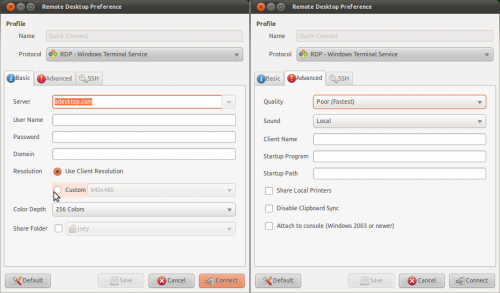Source
On Ubuntu, you can allow the remote connections from
Start - More apps - Control Panel-Control Center - Remote Desktop
(old ubuntus:
System - Preferences - Remote Desktop) option.
Here check “Allow other users to control your desktop” option.

The first two checkboxes need to be checked in order for remote desktop to be enabled.
The Security section is important: If you select the “Ask you for confirmation” code, then you will need to be at the computer in order to allow the other person to access your desktop. If you are trying to remotely access one of your own computers, you will want to uncheck this box.
The second checkbox should always be checked, and you should enter a secure password. You will be prompted for this password when you try to log on.
==================
Source
GTK app Remmina is to replace TSClient as the default remote desktop client in Ubuntu 11.04.
The tool is a capable successor to tsclient with many great features and support for multiple network protocols – including RDP – all of which is wrapped up in a consistant and accessible interface.

List of protocols supported: -
- RDP
- VNC
- NX
- XDMCP
- SSH
==================
When you use VNC:
First install vncserver and give it a password
$ sudo apt-get install vncserver
Then run it like this
$ vncserver robert-desktop:0
-------
RDP to Windows
Alt - F2
tsclient
or
xrdp
--------
Trying to remote desktop between two ubuntu machines, when i connect i just get a black screen, no login prompt or anything.
Answer
Edit gdm.conf in /etc/.
Uncomment the RemoteGreeter line and in the
xdmcp section set Enable to true.
===================
Source Windows first, s. v. p.!
This brief tutorial shows you how to connect to Microsoft Windows 7 from Ubuntu 11.04 Natty via Remote Desktop Connection. As you may already know, connecting from a Windows PC to another Windows PC is easy, but with Ubuntu, you must enable certain options for this to be possible and this tutorial will show you how.
Getting started:
To get started, click ‘Start – then search for and select ‘View advanced system settings’
View advanced system settings

Next, select ‘Remote’ tab and choose ‘option #2’ under Remote Desktop.

Next, search for and select ‘Windows Firewall with Advanced Security’
Windows Firewall with Advanced Security

Then click ‘Inbound Rules’ and select ‘Remote Desktop (TCP-In)’
Right-click it and select ‘Enable Rule’

After that, go to Ubuntu Dash and search for and select ‘tsclient’
tsclient

When Terminal Server Client opens, type the IP Address, username and password of the Windows computer and click ‘Connect’

Enjoy!

That’s how you do it.
=========================
=========================
Source And then, s. v. p.!
To use the same Remote Desktop Protocol to connect from Windows to Ubuntu 11.04 Natty Narwhal. If you ever wanted to connect to Ubuntu via Remote Desktop Connection, then this tutorial will help you do that.
There are many ways to connect to Ubuntu from Windows and RDP protocol is just one of the many ways.
Getting started:
To get started, press Ctrl – Alt – T on your keyboard to open Terminal. When Terminal opens, type the command below to install xrdp server.
sudo apt-get install xrdp

Next, go to Start –> All Programs –> Accessories –> Remote Desktop Connection from your Windows computer and type the IP address or Hostname of the Ubuntu machine then click ‘Connect’

When prompted, enter your Ubuntu username and password and click ‘OK’

Enjoy!

That’s all to it.



 LibreOffice
LibreOffice Firefox
Firefox
No comments:
Post a Comment